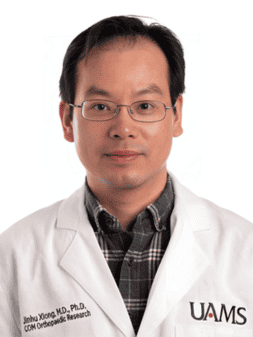Jinhu Xiong, M.D., Ph.D.

In 2016, Dr. Xiong joined the Department of Orthopaedic Surgery and developed into one of several leading scientists focused on bone biology as part of the Center for Musculoskeletal Disease Research (CMDR), a Center of Biomedical Research Excellence (COBRE) at UAMS awarded by the National Institute of General Medical Sciences. In 2020, Dr. Xiong became independently funded after being awarded a $1.7 million grant from the National Institute of Arthritis & Musculoskeletal & Skin Diseases to study how physical activity improves bone health, with possible implications for osteoporosis- and age-related bone loss. Dr. Xiong has published approximately 40 peer-reviewed manuscripts, with over 4500 citations to date. He also serves on the Editorial Boards of Bone and Bone Reports.
Research Focus:
The overall goal of my research is to uncover the cellular and molecular mechanisms underlying mechanotransduction in bone, a process essential for maintaining skeletal strength and integrity. Bones adapt to mechanical loading through a well-coordinated response that aligns with strain distribution across the tissue, allowing them to withstand physical stress and prevent damage. However, the precise mechanisms driving this adaptive process remain incompletely understood.
Our work has identified Piezo1, a mechanosensitive ion channel, as a critical regulator of bone homeostasis and mechanotransduction highlighting its significance in the regulation of bone adaptation to mechanical forces. Piezo1 enables bone cells, including osteocytes and other cell types in bone to detect and respond to mechanical forces by converting them into biochemical signals. By further investigating Piezo1’s molecular pathways and its interactions with other mechanotransduction mechanisms, our research aims to advance understanding of how bones sense and respond to mechanical stimuli, with the potential to uncover novel therapeutic strategies for bone diseases like osteoporosis.
Current Projects:
R01 AR076979 – The role of Piezo1 in bone homeostasis and mechanotransduction
Role: Principal Investigator
Aug 17, 2020 – Jun 30, 2025
P20 GM125503 – Center for Musculoskeletal Disease Research (CMDR)
Role: Core Director (PI: Charles O’Brien, Ph.D.)
Histology, Biomechanics, and Human Tissue Core
Apr 1, 2023 – Jan 31, 2028
Another area of my research is age-associated bone loss, including the contribution of the decline in mechanical stimulation to age-associated bone loss, and the efficacy of Piezo1 agonists in preventing age-associated cortical bone loss.